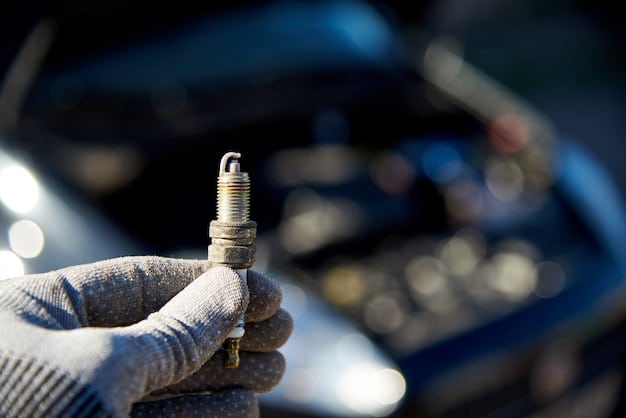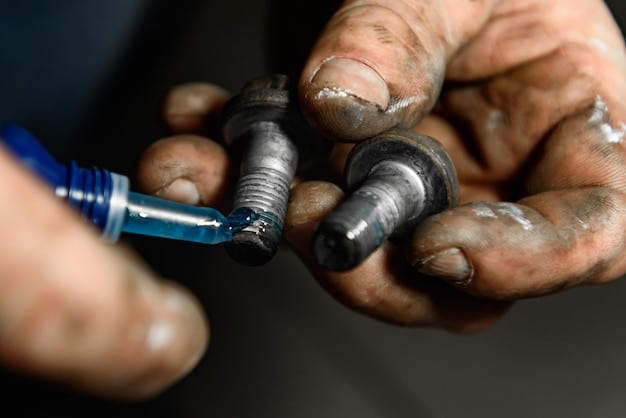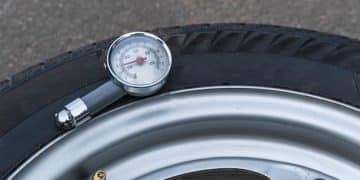Spark Plug Replacement: Boost MPG & Identify Worn Plugs

Spark plug replacement is essential for maintaining your car’s performance and fuel efficiency; identifying worn spark plugs early can significantly improve your car’s MPG and prevent potential engine damage, ensuring a smoother and more economical drive.
Is your car’s fuel efficiency plummeting? Maybe it’s time for a spark plug replacement: How to identify worn spark plugs and improve your car’s MPG is easier than you think, and it can make a significant difference.
Understanding the Role of Spark Plugs
Spark plugs are small but mighty components in your car’s engine. They play a crucial role in igniting the air-fuel mixture, which powers your vehicle. When these plugs wear out, it affects your car’s overall performance.
Think of spark plugs as the conductors of a symphony within your engine; when they’re out of tune, the whole performance suffers. Recognizing their importance is the first step to maintaining your car’s health.
What Exactly Do Spark Plugs Do?
At its core, a spark plug delivers the electric spark that ignites the compressed air-fuel mixture in the combustion chamber. This ignition creates the force that drives the piston, ultimately turning the wheels of your car.
Why Are They Important for MPG?
Worn spark plugs don’t ignite the fuel mixture as efficiently. This incomplete combustion wastes fuel, reducing your MPG. Replacing them ensures a cleaner, more efficient burn, saving you money at the pump.
- Efficient Combustion: New plugs ensure a complete burn, maximizing fuel use.
- Reduced Emissions: Proper combustion also lowers harmful emissions.
- Improved Performance: A healthy ignition system means better acceleration and smoother idling.
Understanding the fundamental role of spark plugs and their impact on fuel efficiency sets the stage for proactive car maintenance, ensuring a healthier engine and a happier wallet.
Identifying Symptoms of Worn Spark Plugs
Recognizing the signs of worn spark plugs early can save you from more significant engine problems. Common symptoms range from decreased fuel efficiency to noticeable engine misfires.

Being vigilant and attentive to your car’s behavior is key to spotting these issues before they escalate. Let’s examine the key indicators to watch out for.
Common Symptoms to Watch For
Keep an ear out for unusual sounds and a close eye on your car’s performance. These can be telltale signs that your spark plugs need attention.
- Decreased MPG: A noticeable drop in fuel efficiency is often the first clue.
- Engine Misfires: This can feel like a sudden jerk or hesitation during acceleration.
- Rough Idling: The engine might vibrate or run unevenly when the car is stopped.
- Difficult Starting: Your car might take longer to start, especially in cold weather.
Visual Inspection of Spark Plugs
Sometimes, a visual inspection can reveal the condition of your spark plugs. Look for signs of wear, damage, or excessive buildup on the electrode.
Checking your spark plugs visually isn’t just a maintenance task; it’s like a health check for your engine, revealing clues about its overall condition and performance.
By being alert to both the performance symptoms and the visual cues, you can promptly address issues with your spark plugs, ensuring your car runs smoothly and efficiently.
Step-by-Step Guide to Spark Plug Replacement
Replacing spark plugs is a straightforward task that most car owners can handle with a little guidance. By following these steps meticulously, you can restore lost performance and improve fuel efficiency.
Here’s a detailed guide to help you through the process, ensuring you do it safely and effectively.
Tools and Materials You’ll Need
Before you start, gather all the necessary tools and materials. Having everything within reach will streamline the process.
- New Spark Plugs: Make sure they’re compatible with your car model.
- Spark Plug Socket: This specialized socket is designed to grip the spark plug without damaging it.
- Socket Wrench: To turn the spark plug socket.
- Torque Wrench: To tighten the new spark plugs to the correct specification.
- Gap Tool: To ensure the spark plug gap is set correctly.
The Replacement Process
Follow these steps carefully to replace your spark plugs safely and effectively.
- Preparation: Let your engine cool down completely to avoid burns.
- Remove the Old Plugs: Carefully disconnect the spark plug wires and use the socket wrench to remove the old plugs.
- Gap the New Plugs: Use the gap tool to ensure the new spark plugs have the correct gap.
- Install the New Plugs: Gently thread the new plugs into place by hand to avoid cross-threading, then tighten with the torque wrench to the specified torque.
- Reconnect the Wires: Ensure the spark plug wires are securely reconnected.
| Key Point | Brief Description |
|---|---|
| 🔧 Regular Checks | Inspect spark plugs regularly for wear or damage. |
| ⛽ Improved MPG | Replacing worn plugs can significantly boost fuel efficiency. |
| 🛠️ Proper Tools | Use the correct tools to avoid damaging the spark plugs or engine. |
| ⚡ Correct Gap | Ensure the spark plug gap is set to the manufacturer’s specification. |
FAQ
▼
Spark plug replacement frequency varies by vehicle and plug type. Standard plugs may need replacing every 30,000 miles, while iridium plugs can last up to 100,000 miles. Check your owner’s manual for specifics.
▼
Yes, worn spark plugs can cause misfires, which can lead to unburnt fuel entering the exhaust system. This can damage the catalytic converter and other engine components over time.
▼
Refer to your car’s owner manual for the recommended spark plug type. Using the wrong type can lead to poor performance and potential engine damage. Always use a compatible spark plug.
▼
Yes, if you have basic mechanical skills and tools, replacing spark plugs is a manageable DIY task. Just be sure to follow safety precautions, like disconnecting the battery and working with a cool engine.
▼
Yes, replacing worn spark plugs can improve your car’s performance by restoring proper combustion. This leads to better fuel efficiency, smoother idling, and improved acceleration, thus optimizing engine output.
Conclusion
Replacing your spark plugs is a simple yet effective way to maintain your car’s performance and improve its MPG. By identifying the symptoms of worn plugs and following a step-by-step replacement guide, you can keep your car running smoothly and efficiently. This proactive approach not only saves you money on fuel but also extends the life of your engine.





